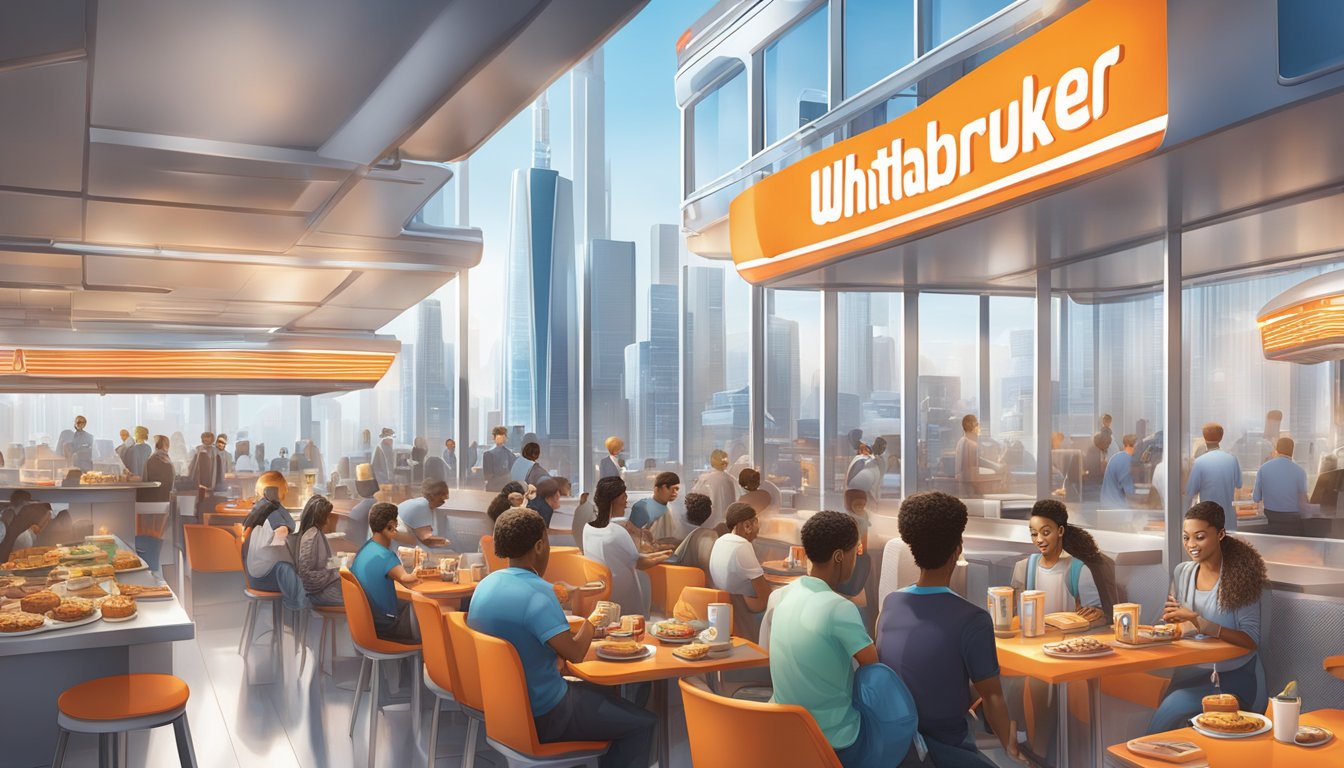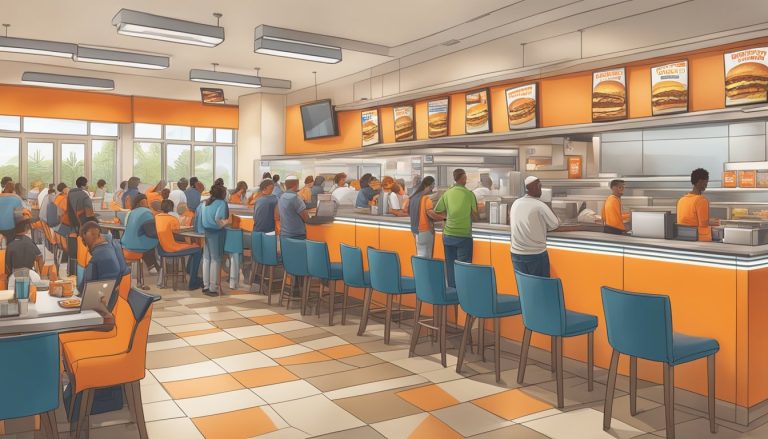Whataburger, the iconic Texas-based fast food chain, has been serving up delicious breakfast options for decades. As the company looks to expand its reach and adapt to changing consumer preferences, the future of its breakfast menu is ripe with potential.
By 2027, Whataburger plans to open dozens of new locations, including its first restaurants in Florida, signaling a bright future for breakfast lovers across the country. This expansion presents an opportunity for the chain to introduce its beloved morning offerings to new markets while maintaining its Texas roots.
The company’s commitment to innovation and customer satisfaction suggests that its breakfast menu will continue to evolve. With a focus on fresh ingredients and satisfying options like the popular Breakfast on a Bun, Whataburger is well-positioned to meet the changing demands of breakfast consumers in the coming years.
Historical Overview of Whataburger

Whataburger’s journey from a small Texas burger stand to a beloved regional fast-food chain spans over seven decades. The company’s growth has been marked by strategic expansion and a commitment to its Texan roots.
Founding and Expansion
Harmon Dobson founded Whataburger in 1950 in Corpus Christi, Texas. His vision was to create a burger so big that customers would exclaim “What a burger!” upon first bite. The first restaurant was a humble stand, but Dobson’s concept quickly gained popularity.
By 1960, Whataburger had expanded to 17 locations across Texas. The company’s growth accelerated in the following decades, reaching 300 restaurants by 1980. This rapid expansion solidified Whataburger’s position as a major player in the fast-food industry.
Whataburger remained a family-owned business for nearly 70 years. In 2019, the Dobson family sold their majority stake to BDT Capital Partners, marking a new chapter in the company’s history.
Iconic Menu Items and Texan Heritage
Whataburger’s menu has evolved over the years, but its signature burgers remain at the core of its offerings. The original Whataburger, a quarter-pound beef patty on a 5-inch bun, continues to be a customer favorite.
The chain’s orange and white striped buildings have become an iconic part of the Texas landscape. These distinctive structures, introduced in the 1960s, serve as a visual representation of the brand’s Texan heritage.
Whataburger’s commitment to Texas extends beyond its visual identity. The company has embraced local flavors and preferences, offering regional specialties like the Honey Butter Chicken Biscuit and the Patty Melt.
Whataburger’s Current Market Stand
Whataburger has cemented its position as a beloved regional fast-food chain with a strong brand identity and recent financial growth. The Texas-based company continues to expand while maintaining its loyal customer base.
Brand Identity and Customer Perceptions
Whataburger’s distinctive orange-and-white striped restaurants are instantly recognizable across its operating states. The chain celebrated its 85th anniversary in 2025, highlighting its enduring appeal and rich history.
Customers associate Whataburger with quality, made-to-order burgers and a menu that caters to local tastes. This strong brand loyalty has helped Whataburger compete effectively against larger national chains.
The company’s commitment to its Texas roots remains a key part of its identity, even as it expands into new markets. This balance of tradition and growth has resonated well with both long-time fans and new customers.
Financial Growth Through Investments
In 2019, BDT Capital Partners acquired a majority stake in Whataburger, injecting new capital and expertise into the company. This partnership has fueled Whataburger’s expansion efforts and modernization initiatives.
The investment has allowed Whataburger to:
- Refresh restaurant designs
- Expand into new markets like Tennessee and Kansas City
- Improve digital ordering and delivery capabilities
As of 2025, Whataburger operates over 1,000 locations across 15 states, showing significant market penetration in the Southern United States. The chain’s financial performance has remained strong, with steady growth in sales and store count.
Whataburger’s strategic expansion has been careful and measured, focusing on maintaining quality and brand consistency rather than rapid, unchecked growth.
Innovative Breakfast Items

Whataburger continues to evolve its breakfast menu with creative offerings and customer favorites. The chain focuses on fresh ingredients and unique flavors to stand out in the competitive fast-food breakfast market.
Customer Favorites and Their Evolution
The Honey Butter Chicken Biscuit remains a beloved staple on Whataburger’s breakfast menu. This sweet and savory combination has inspired variations, including a spicy version with jalapeño-infused honey butter.
The Breakfast on a Bun has seen updates with premium toppings like avocado and specialty cheeses. Whataburger now offers customization options, allowing customers to build their ideal breakfast sandwich.
Taquitos have expanded beyond the traditional egg and cheese. New fillings include chorizo, potato, and vegetarian options to cater to diverse tastes.
Potential Future Breakfast Additions
Whataburger may introduce healthier breakfast bowls featuring quinoa, fresh vegetables, and lean proteins. These could appeal to health-conscious customers seeking nutritious morning options.
Plant-based alternatives for traditional breakfast meats could appear on the menu. This would align with growing consumer interest in meat-free options.
Specialty coffee drinks may become a focus, with Whataburger developing signature blends and flavored lattes to compete with coffee chains.
Global breakfast inspirations could lead to items like breakfast flatbreads or savory oatmeal bowls, bringing international flavors to the menu.
Enhancing the Customer Experience

Whataburger is poised to elevate its breakfast offerings through personalized options and improved service. These enhancements aim to create a more engaging and satisfying experience for customers.
Customization and Personalization
Whataburger plans to introduce a build-your-own breakfast menu, allowing customers to mix and match ingredients. This system will include options for various bread types, proteins, and toppings. A digital kiosk will enable easy customization, reducing order errors and wait times.
The chain is also developing an AI-powered recommendation system for its mobile app. This feature will suggest breakfast combinations based on past orders and customer preferences. Loyalty program members will receive personalized promotions and early access to new breakfast items.
Whataburger is exploring the integration of dietary filters into its ordering platforms. This addition will help customers with specific nutritional needs or restrictions easily find suitable breakfast options.
Strengthening Customer Service
Whataburger is investing in comprehensive training programs for its breakfast shift employees. These programs focus on efficient food preparation and friendly customer interactions. The chain aims to reduce wait times during peak breakfast hours through optimized kitchen workflows and staffing adjustments.
A new customer feedback system will be implemented to gather real-time input on breakfast experiences. This data will inform quick menu adjustments and service improvements. Whataburger plans to introduce a dedicated breakfast concierge at select locations to assist with orders and answer questions about menu items.
The company is also exploring extended breakfast hours at certain restaurants to cater to late-night and early-morning customers. This flexibility aims to increase customer satisfaction and accommodate diverse schedules.
Whataburger’s Growth Strategy

Whataburger aims to expand its footprint while maintaining its core identity. The company plans to reach new markets and explore strategic partnerships to fuel its growth.
Expanding Beyond the Southern States
Whataburger is setting its sights on territories outside its traditional southern stronghold. The chain plans to open new locations in Midwestern and Western states, targeting areas with similar demographics to its current customer base. This expansion strategy includes a mix of company-owned and franchised restaurants to ensure rapid growth while maintaining quality control.
Whataburger is also investing in smaller-format stores and drive-thru only locations to penetrate urban markets with limited real estate options. These streamlined restaurants will focus on efficient service and a curated menu of Whataburger favorites.
Collaborating and Acquiring
To accelerate growth, Whataburger is exploring strategic collaborations and acquisitions. The company is considering partnerships with regional chains that complement its offerings and share similar values. These alliances could provide access to new markets and customer segments.
Whataburger is also evaluating potential acquisitions of smaller fast-food chains or restaurant groups. This approach would allow the company to quickly expand its presence in new regions while leveraging existing infrastructure and customer bases.
The chain is investing in technology partnerships to enhance its digital ordering capabilities and loyalty program. These collaborations aim to improve the customer experience and drive repeat visits across Whataburger’s growing network of restaurants.
Corporate Social Responsibility

Whataburger’s commitment to social responsibility extends beyond serving quality food. The company actively engages in community initiatives and sustainability efforts to make a positive impact.
Community Engagement and Initiatives
Whataburger’s Feeding Student Success program stands out as a key community initiative. This program aims to combat student hunger and support education across Texas and beyond. Whataburger partners with local schools and organizations to provide meals and resources to students in need.
The company also sponsors youth sports teams and educational events in its operating areas. These sponsorships help promote physical activity and learning opportunities for children.
Whataburger encourages employee volunteerism through its WhataCaring program. Staff members participate in local charity events and community service projects, strengthening ties with neighborhoods they serve.
Sustainability Efforts
Whataburger is taking steps to reduce its environmental footprint. The company has implemented energy-efficient lighting and equipment in many of its restaurants to decrease energy consumption.
Packaging sustainability is another focus area. Whataburger is exploring biodegradable and recyclable alternatives for its food containers and utensils.
Water conservation initiatives are being rolled out across locations. These include low-flow faucets and water-saving landscaping practices.
Whataburger is also working with suppliers to source ingredients more sustainably. This includes partnering with local farmers when possible and considering the environmental impact of its supply chain.
Leveraging Technology

Whataburger is embracing technological advancements to enhance customer experiences and streamline operations. The company is focusing on digital solutions and data analytics to stay competitive in the fast-food industry.
Technological Integration in Services
Whataburger is implementing contactless ordering systems to improve efficiency and reduce wait times. Digital kiosks are being installed in restaurants, allowing customers to place orders quickly and customize their meals. Mobile apps now offer features like mobile ordering and payment, making it convenient for customers to grab breakfast on the go.
The chain is exploring voice-activated ordering through smart speakers and in-car systems. This technology could enable customers to place orders while driving to work, with their breakfast ready for pickup upon arrival.
Whataburger is also testing automated cooking systems for certain breakfast items. These machines can prepare eggs and toast buns consistently, freeing up staff to focus on customer service and more complex tasks.
Data-Driven Insights for Innovation
Whataburger is leveraging customer data to inform menu development and marketing strategies. By analyzing ordering patterns, the company can identify popular breakfast combinations and create new menu items tailored to customer preferences.
The loyalty program collects valuable data on customer habits and preferences. This information helps Whataburger personalize promotions and offers, increasing customer engagement and repeat visits during breakfast hours.
Predictive analytics are being used to optimize inventory management and reduce food waste. By accurately forecasting demand for breakfast items, Whataburger can ensure freshness while minimizing costs.
The company is also using data insights to improve kitchen operations. Real-time analytics help managers adjust staffing levels and food preparation based on predicted breakfast rush periods, enhancing overall efficiency.
Economic Impact on Local Communities

Whataburger’s expansion continues to fuel local economies across its operating regions. The chain’s growth creates numerous job opportunities, from entry-level positions to management roles.
As Whataburger opens new locations, it stimulates local construction and real estate markets. The company often partners with local contractors and suppliers, boosting business for these firms.
Tax contributions from Whataburger restaurants provide significant revenue for local governments. These funds support essential community services and infrastructure improvements.
The company’s employee development programs offer career advancement opportunities, potentially increasing local workforce skills and earning potential.
Whataburger’s franchisee model allows local entrepreneurs to invest in their communities. These franchisees often become active participants in local business networks and chambers of commerce.
The chain’s presence can attract other businesses to the area, creating a multiplier effect on the local economy. This can lead to increased foot traffic and commerce in surrounding areas.
Whataburger’s community engagement initiatives, such as sponsorships and charitable donations, further strengthen its economic impact. These efforts support local organizations and events, contributing to the overall well-being of communities.
Whataburger’s Cultural and Regional Influence

Whataburger has become deeply intertwined with Texas culture and cuisine, shaping food trends across the Southern United States. Its iconic branding and menu offerings have made it a beloved institution far beyond its fast-food roots.
The Role of Texas Culture in Branding
Whataburger’s orange-and-white striped buildings have become landmarks across Texas. The chain’s visual identity taps into the state’s bold, larger-than-life ethos. Whataburger’s menu reflects Texan tastes, with items like the Patty Melt and spicy ketchup gaining cult followings.
The company’s marketing often plays on Texas pride and traditions. Local high school football teams frequently gather at Whataburger after games. This deep community connection has turned many locations into de facto social hubs.
Whataburger’s expansion strategy has been careful to maintain its Texan roots. New locations outside the state often become gathering spots for Texas expats craving a taste of home.
Influence on the Southern Cuisine Scene
Whataburger has left an indelible mark on Southern fast food. Its success has inspired other regional chains to embrace local flavors and ingredients. The Honey Butter Chicken Biscuit, for instance, sparked a trend of sweet-and-savory breakfast sandwiches across the South.
The chain’s commitment to customization has raised consumer expectations. Many competitors now offer expanded topping choices and all-day breakfast in response to Whataburger’s popularity.
Whataburger’s influence extends to sit-down restaurants as well. Upscale eateries have created gourmet versions of Whataburger classics, paying homage to the chain’s cultural significance. Food critics often use Whataburger as a benchmark when reviewing new burger joints in the region.
Marketing and Brand Promotion

Whataburger’s marketing approach will likely evolve to keep pace with changing consumer preferences and technological advancements. The company is expected to expand its digital presence while maintaining its iconic Texas roots.
Engagement Strategies on Social Media
Whataburger will intensify its social media efforts to connect with customers. The brand may leverage AI-driven algorithms to craft personalized promotions based on individual preferences. Interactive campaigns could encourage user-generated content, fostering a sense of community among fans. Live-streaming events featuring menu item creations or behind-the-scenes glimpses may become regular features.
Collaborations with influencers and local celebrities might amplify Whataburger’s reach. The company could use augmented reality filters and games to make its social media presence more engaging and immersive.
Exclusive Merchandise and Campaigns
Whataburger may expand its merchandise line to include limited-edition items tied to specific promotional periods or regional themes. Collectible packaging for popular menu items could drive customer interest and sales.
The brand might introduce a loyalty program with exclusive rewards, early access to new menu items, and personalized offers. Pop-up events and food trucks could bring the Whataburger experience to new locations and events.
Seasonal campaigns could highlight regional flavors and ingredients, reinforcing Whataburger’s connection to local communities. Partnerships with Texas-based brands or sports teams may result in co-branded products and unique marketing initiatives.
Looking Forward

Whataburger’s breakfast offerings are poised for significant evolution in the coming years. The fast-food chain’s future strategies will likely focus on adapting to changing consumer preferences and leveraging innovative technologies.
Predicting Industry Trends and Whataburger’s Role
The fast-food industry is shifting towards healthier, more diverse breakfast options. Whataburger may introduce plant-based alternatives and low-carb choices to cater to health-conscious customers. Digital ordering and delivery services are expected to become more prevalent.
Whataburger could expand its breakfast hours to capture late-night and early-morning customers. The chain might also experiment with limited-time offers and seasonal menu items to maintain customer interest.
Sustainability initiatives are gaining importance. Whataburger may invest in eco-friendly packaging and locally sourced ingredients for its breakfast menu.
Strategic Planning for the Next Decade
Whataburger’s growth strategy will likely involve expanding into new markets while maintaining its core breakfast offerings. The chain may consider franchising opportunities to accelerate expansion.
Innovation in food preparation techniques could lead to faster service times and improved product quality. Whataburger might invest in kitchen automation and AI-powered ordering systems to streamline operations.
Personalization will play a crucial role in future breakfast offerings. Whataburger could implement data-driven menu recommendations and customizable breakfast options to enhance customer satisfaction.
Collaborations with local food suppliers and other brands may help Whataburger differentiate its breakfast menu from competitors. The chain could also explore partnerships with food delivery platforms to increase accessibility.




